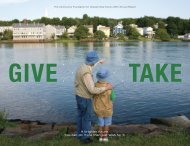Understanding Youth Violence in New Haven: A Photovoice Project ...
Understanding Youth Violence in New Haven: A Photovoice Project ...
Understanding Youth Violence in New Haven: A Photovoice Project ...
Create successful ePaper yourself
Turn your PDF publications into a flip-book with our unique Google optimized e-Paper software.
ackgrounds, and the creation of an audit trail to document analytic decisions. 25, 28, 37 Inaddition, we presented the f<strong>in</strong>d<strong>in</strong>gs to the youth participants for confirmation that thethemes reflected their experience of the roots of youth gun violence. This technique, knownas ‘participant confirmation’ is recommended to enhance the rigor and credibility ofqualitative research. Prior to the start of the project, the research protocol was approved bythe Human Investigation Committee of the Yale College of Arts and Sciences, <strong>New</strong> <strong>Haven</strong>,Connecticut and <strong>in</strong>formed written consent was obta<strong>in</strong>ed from adult participants and fromparents of participants under the age of 18.F<strong>in</strong>d<strong>in</strong>gsThree major themes characterize the views of these youth regard<strong>in</strong>g the underly<strong>in</strong>g causesof gun violence and the effects of gun violence on their lives and their community. First,youth are presented with limited choices as they pursue normal adolescent developmentsuch as identity formation. Second, the youth seek family structures that satisfy their needsfor safety, guidance and belong<strong>in</strong>g. Third, females differ from males <strong>in</strong> their experience ofyouth gun violence. We identified these three themes to be of fundamental relevance to theproblem of youth gun violence and therefore focus on these data <strong>in</strong> this report.Theme 1: <strong>Youth</strong> are presented with limited choices as they pursue normaladolescent development.<strong>New</strong> <strong>Haven</strong> youth experience the same k<strong>in</strong>d of peer pressure <strong>in</strong> their adolescentdevelopment as all youth. <strong>Youth</strong> participants described hav<strong>in</strong>g limited choices available tothem <strong>in</strong> their communities as they pursue developmental tasks common to all adolescents."To me, like it always was about the girls, you know, you get your name known forthe girls, you know, so I don’t see why a lot of people sell drugs to buy ‘em or wentout and shot guns to get popularity when you could just play basketball. Dosometh<strong>in</strong>g that they like." (19 y/o male)“If you go to (a) fashion school like Hill House… if you not fresh, I bet you by thenext year you gonna try to (be)… because I talk<strong>in</strong>g about a lot of people who are notfresh and stuff, they (are) gonna try to get money. That’s why everybody try(s) toget money, (be)cause they got to.” (17 y/o male)Although experiences such as peer pressure are common among adolescents, participantsalso described liv<strong>in</strong>g <strong>in</strong> environments that are not at all typical. Many of these choicesnecessarily <strong>in</strong>volved risky or less healthy behaviors. They characterized their neighborhoodsas profoundly unsafe. This lack of safety presents substantial challenges as youth attemptto pursue acceptance, respect, and success.“I wish I had bars on my w<strong>in</strong>dows.” (15 y/o female)“People get shot for anyth<strong>in</strong>g…” (19 y/o female)“It’s just crazy. Why do you have to go and kill somebody over someth<strong>in</strong>g dumb oversteal<strong>in</strong>g a bike or the drugs? Why do guns even have to be <strong>in</strong>vented?” (19 y/ofemale)<strong>Youth</strong> described both ambivalence at gett<strong>in</strong>g <strong>in</strong>volved and fear for their own personalsafety.12




